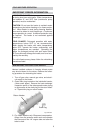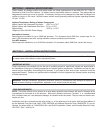
8
SECTION 3 - MAINTENANCE AND
CARE PROCEDURES
To be followed one month after start-up and then semi-
annually.
1. Inspect top of heater and drafthood for soot, a
sticky black substance around finned tubes and
"V" baffles, and open flue gas passageways. Any
visible soot should be cleaned for proper opera-
tion.
2. Clean main burners and pilot burner of dust and
lint.
3. Inspect and operate all controls, gas valve and
pressure relief valve (if equipped).
4. Make visual check of the burner and pilot flames.
Flame pattern on the main burner and pilot is illus-
trated on page 7. Yellow flame means restriction
of the air openings. Lifting or blowing flame indi-
cates high gas pressure. Low flame means low
gas pressure. Should the latter occur, shut the
heater off and contact your gas supplier or quali-
fied service agency.
5. On indoor heaters, clean room intake openings to
ensure adequate flow of combustion and ventila-
tion air.
6. Keep area around heater clear and free from com-
bustible materials, gasoline and other flammable
and corrosive vapors and liquids.
IF HEATER WILL NOT FIRE:
If you have no electrical power, it may be that your
"circuit breaker" has tripped. Try re-setting it.
If you have electrical power but the heater will not fire
check the following or see Troubleshooting section:
1. The time clock must be in the "ON" position.
2. Your pump strainer basket may be full. If so
remove debris.
CAUTION:
Soot may be combustible. Wet sooted
surfaces completely prior to cleaning. Do not use
steel wire brush.
3. Your filter may be dirty. If so, backwash or clean
filter. (To tell if your filter is dirty, look to see if the
filter pressure will be higher than usual).
4. The pump may have lost its prime and be running
dry. Check the pressure on the filter. If there is no
pressure; then you are not moving water (or your
gauge is broken). Try to get the pump to run at its
normal flow rate.
POOL & SPA WATER CHEMISTRY
Chemical imbalance can cause severe damage to
your heater and associated equipment. Maintain your
water chemistry according to the chart on page 2. If
the mineral content and dissolved solids in the water
become too high, scale forms inside the heat exchang-
er tubes, reducing heater efficiency and damaging the
heater. If the pH drops below 7.2, this will cause cor-
rosion of the heat exchanger and severely damage the
heater. Heat exchanger damage resulting from chem-
ical imbalance is not covered by the warranty.
AUTOMATIC CHLORINATORS AND
CHEMICAL FEEDERS
All chemicals must be introduced and completely dilut-
ed into the pool or spa water before being circulated
through the heater. Do not place sanitizing chemicals
in the skimmer. High chemical concentrations will
result when the pump is not running (e.g. overnight).
Chlorinators must feed downstream of the heater and
have an anti-siphoning device to prevent chemical
back-up into the heater when the pump is shut off.
See plumbing diagram page 21.
NOTE:
High chemical concentrates from feeders and
chlorinators that are out of adjustment will cause rapid
corrosion to the heat exchanger. Such damage is not
covered under the warranty.
CAUTION:
Combustion air must not be contaminat-
ed by corrosive chemical fumes which can damage
the heater and void the warranty.


















